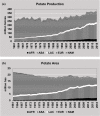The Potato of the Future: Opportunities and Challenges in Sustainable Agri-food Systems
- PMID: 34334803
- PMCID: PMC8302968
- DOI: 10.1007/s11540-021-09501-4
The Potato of the Future: Opportunities and Challenges in Sustainable Agri-food Systems
Abstract
In the coming decades, feeding the expanded global population nutritiously and sustainably will require substantial improvements to the global food system worldwide. The main challenge will be how to produce more food with the same or fewer resources and waste less. Food security has four dimensions: food availability, food access, food use and quality, and food stability. Among several other food sources, the potato crop is one that can help match all these constraints worldwide due to its highly diverse distribution pattern, and its current cultivation and demand, particularly in developing countries with high levels of poverty, hunger, and malnutrition. After an overview of the current situation of global hunger, food security, and agricultural growth, followed by a review of the importance of the potato in the current global food system and its role played as a food security crop, this paper analyses and discusses how potato research and innovation can contribute to sustainable agri-food systems comparing rural and industrial agri-food systems with reference to food security indicators. It concludes with a discussion about the challenges for sustainable potato cropping enhancement considering the needs to increase productivity in rural-based potato food systems that predominate in low-income countries, while promoting better resource management and optimization in industrial-based agri-food systems considering factors such as quality, diversity of products, health impacts, and climate change effects. Research and innovation options and policies that could facilitate the requirements of both rural and industrial potato-based agri-food systems are described.
Keywords: Food security; Multidisciplinary approaches; Nutrition; Sustainable intensification; Value chain; Yield gap.
© The Authors 2021, corrected publication 2021.
Figures










Similar articles
-
Experiences and Lessons from Agri-Food System Transformation for Sustainable Food Security: A Review of China's Practices.Foods. 2022 Jan 6;11(2):137. doi: 10.3390/foods11020137. Foods. 2022. PMID: 35053869 Free PMC article. Review.
-
Rethinking food loss and waste to promote sustainable resource use and climate change mitigation in agri-food systems: A review.Waste Manag Res. 2025 Apr;43(4):490-506. doi: 10.1177/0734242X241257655. Epub 2024 Jul 30. Waste Manag Res. 2025. PMID: 39078041 Review.
-
Hydroponics: Exploring innovative sustainable technologies and applications across crop production, with Emphasis on potato mini-tuber cultivation.Heliyon. 2024 Feb 22;10(5):e26823. doi: 10.1016/j.heliyon.2024.e26823. eCollection 2024 Mar 15. Heliyon. 2024. PMID: 38434318 Free PMC article. Review.
-
Potato Production in Northwestern Europe (Germany, France, the Netherlands, United Kingdom, Belgium): Characteristics, Issues, Challenges and Opportunities.Potato Res. 2022;65(3):503-547. doi: 10.1007/s11540-021-09535-8. Epub 2022 Jan 28. Potato Res. 2022. PMID: 35106009 Free PMC article. Review.
-
Position of the American Dietetic Association: Addressing world hunger, malnutrition, and food insecurity.J Am Diet Assoc. 2003 Aug;103(8):1046-57. doi: 10.1016/s0002-8223(03)00973-8. J Am Diet Assoc. 2003. PMID: 12891157
Cited by
-
Genome-Wide Identification and Analysis Uncovers the Potential Role of JAZ and MYC Families in Potato under Abiotic Stress.Int J Mol Sci. 2023 Apr 4;24(7):6706. doi: 10.3390/ijms24076706. Int J Mol Sci. 2023. PMID: 37047679 Free PMC article.
-
Advances in the Modulation of Potato Tuber Dormancy and Sprouting.Int J Mol Sci. 2024 May 7;25(10):5078. doi: 10.3390/ijms25105078. Int J Mol Sci. 2024. PMID: 38791120 Free PMC article. Review.
-
Dry Matter Accumulation, Water Productivity and Quality of Potato in Response to Regulated Deficit Irrigation in a Desert Oasis Region.Plants (Basel). 2024 Jul 12;13(14):1927. doi: 10.3390/plants13141927. Plants (Basel). 2024. PMID: 39065454 Free PMC article.
-
Consumers' Attitude towards Supermarket and Proximity Stores as Purchasing Outlets of Italian Potato Consumers.Foods. 2023 Jul 28;12(15):2877. doi: 10.3390/foods12152877. Foods. 2023. PMID: 37569145 Free PMC article.
-
Nano-metals forming bacteria in Egypt. II. Efficacy towards biomolecules, ultrastructure, growth parameters, and eco-friendly therapeutic of soft rot/blackleg genera.Microb Cell Fact. 2023 May 17;22(1):101. doi: 10.1186/s12934-023-02101-6. Microb Cell Fact. 2023. PMID: 37198660 Free PMC article.
References
-
- Amoros W, Salas E, Hualla V, Burgos G, De Boeck B, Eyzaguirre R, Felde T, Bonierbale MW. Heritability and genetic gains for iron and zinc concentration in diploid potato. Crop Sci. 2020;60:1884–1896. doi: 10.1002/csc2.20170. - DOI
-
- Andrade-Piedra JL, Almekinders CJM, McEwan MA, Kilwinger FBM, Mayanja S, Mulugo L, Delaquis E, Garrett KA, Omondi AB, Rajendran S, Kumar LP, Thiele G. User guide to the toolbox for working with root, tuber and banana seed systems. RTB User guide. Lima, Peru: International Potato Center on behalf of CGIAR Research Program on Roots, Tubers and Bananas; 2020.
-
- Andrivon D. Potato facing global challenges: how, how much, how well? Potato Res. 2017;60:389–400. doi: 10.1007/s11540-018-9386-z. - DOI
-
- Arya S, Ahmed M, Bardhan Roy SK, Kadian MS, Quiroz R (2015) Sustainable intensification of potato in rice based system for increased productivity and income of resource poor farmers in West Bengal, India. Int J Trop Agric (India). ISSN 0254–8755 33(2):203–208
-
- Ashby J, Polar V (2019) The implications of gender relations for modern approaches to crop improvement and plant breeding. In: Sachs, CE (ed) Gender, agriculture and agrarian transformations, Routledge. 10.4324/9780429427381-2
Publication types
LinkOut - more resources
Full Text Sources
Miscellaneous
